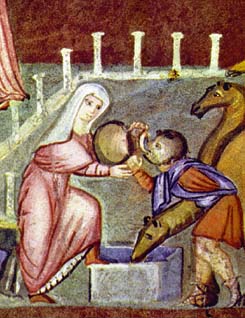10
Artwork in focus
Dr. Nancy Ross

Caught in between
It’s not hard to find inspirational quotes about the difficulty and rewards of change and transition in our lives. There is always something old that we want to hang on to and there is always something new that we want to explore. Transitions are difficult.
The visual arts have undergone numerous changes and transitions from their prehistoric origins to the present. In Europe, artists and patrons of the ancient world loved realistic details and veracity. Medieval artists and patrons instead valued symbolism and abstraction.
The artist of the Vienna Genesis was caught between these two artistic value systems. Perhaps working in Syria or in Constantinople in the early sixth century, the artist likely did not know that this book would become the oldest surviving well-preserved illustrated biblical book and an excellent example of an artist caught in a moment of transition. The Vienna Genesis is a fragment of a Greek copy of the Book of Genesis. Books were luxury items and this book was an exceptionally fine example. It was written in silver ink on parchment that had been dyed purple, the color associated with royalty and empire. There are 24 surviving folios (pages) and they are thought to have come from a much larger book that included perhaps 192 illustrations on 96 folios, each page laid out as you can see above in the example of Rebecca and Eliezer at the well.
This story is from Genesis 24. Abraham wanted to find a wife for his son Isaac and sent his servant Eliezer to find one from among Abraham’s extended family. Eliezer took ten of Abraham’s camels with him and stopped at a well to give them water. Eliezer prayed to God that Isaac’s future wife would assist him with watering his camels. Rebecca arrives on the scene and assists Eliezer, who knows that she is the woman for Isaac. This story is about God intervening to ensure a sound marriage for Abraham’s son.
Two episodes
The illustration of this biblical story shows two episodes, which is common in medieval art. Rebecca is shown twice, as she leaves her town to get water and then assisting Eliezer at the well with his camels. On the one hand, there are clear classical elements that recall artwork from ancient Greece and Rome. Rebecca walks by a colonnade (row of columns) that recall the details of classical architecture. Some of Eliezer’s camels are shaded to emphasize that some are in the front and others in the back. The camel on the far right has one of its back legs in shadow to show a spatial relationship.


Ancient Greek and Roman, but also Early Christian
The figure that most obviously recalls the Ancient Greek and Roman world is the reclining nude next to the river (below). This figure isn’t part of the story of Rebecca and Eliezer, but serves as a personification of the source of the well’s water. Representations of rivers and other bodies of water as people were common in the Classical world (see below). The figure’s sensuality is emphasized by her nudity and reclining pose, typical of Greek and Roman art. This stands in contrast to Rebecca’s heavily draped and fully-covered body, typical of Early Christian art.
There are also elements of the illustration that recall Early Christian art, which is the earliest medieval art. The symbolic representation of the walled city, packed with rooftops and buildings that are not represented in a spatially consistent way, is typical of medieval art, as is the colonnade in miniature. Medieval artists weren’t interested in realistic, consistent representations of space, but were satisfied with the more symbolic representations that we see here. The folds of the clothing are also simplified and reduced. The figures appear to be more cartoon-like than portraits of actual people.

Today, it is a struggle for us to reconcile the figures of Rebecca, who only reveals her hands and face, with the casual nude reclining by the water. This contrast is evidence of the mix of artistic models and sources that were present in the early sixth century. To the artist who illustrated this book, I’m sure that this mix of styles and approaches made perfect sense, and represented a culture in transition.

